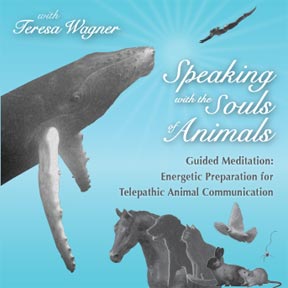Whales
Listen to Humpback Songs
Humpbacks are singers, composers and poets whose songs travel across entire oceans... long, hauntingly beautiful, uninterrupted streams of sounds are actually rhythmic, repeated, patterns of sound.
~ Roger Payne
Anyone who has ever heard a humpback singing while in the water with them knows the mystical feeling of the vibration of the whale's song moving right into one's body. It is a reverent and ecstatic experience.
It was biologist Roger Payne, along with Scott McVay, who discovered in the 1960's that humpback whales sing. Thanks to their pioneering work, we are all able to understand more about their songs, and to listen to the recordings when we are not blessed to actually be with them in the water.
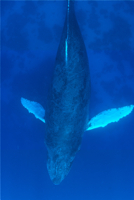
Piers van der Walt
used with permission and gratitude
Humpback songs are probably the most complex in the animal kingdom. In biology, a song is any two or more notes that are repeated in a pattern, and consists of units of sound which combine to form what is known as a phrase. Repetition of a phrase is called a theme. A song will be made up of a number of separate themes. Themes are sung in a specific order, and the entire song will last anywhere from a few minutes to half an hour; some whales sing for hours and days at time. Katy Payne discovered that humpbacks from a single population sing the same song, changing a bit every year, completely changing about every 5 years. Chris Clark's research demonstrated that humpback songs can be heard across ocean basins from the coast of Virginia to the Norweigan Sea.
It was originally thought that only males sing as part of a mating ritual, and did so only in breeding and nursery grounds. It turns out, however, that humpbacks are also known to sing in feeding grounds where mating is not known to occur. When discovering that they sing in feeding grounds after years of assuming otherwise, Phil Clapham of Fishery Sciences Center quipped, "It tells us whales don’t read the text books, which is really annoying."
To hear the whales singing, consider listening to one of the following CDs. When I want to remember moments with the whales in the sea, when I want to feel connected to their souls and feel centered in my own soul, these are the pieces I listen to:
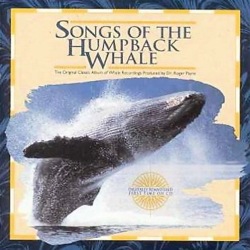 |
Songs of the Humpback Whale CD If you want to hear just the whales, without any human instrumentation or voice, this is the must-have CD for you. If you want to hear their verbal language as they speak it, as they sing it, this is the CD to listen to. Produced by Dr. Roger Payne, the biologist who discovered that whales sing and has studied them since the 1960‘s, this recording was originally released on LP in 1970. |
|
It was also included in National Geographic Magazine's January 1979 issue as a sound sheet--which sold 10.5 copies, still the highest number of records sold in the recording industry. It is carried aboard the Voyager I and II spacecraft, for all the solar system to hear, has been heard by millions of people around the world. It remains the best selling nature album of all time. "Songs of the Humpback Whale isn't the only album of humpback whale recordings, but it is the most famous -- not to mention the most influential. This album did a lot to galvanize environmentalists and had a significant impact on the Save-the-Whales movement of the '70s. The sounds that these whales make have an incredibly haunting beauty; in their own unique way, their sounds are quite musical -- and many of the people who heard Songs of the Humpback Whale back in the early '70s decided that killing the gigantic creatures was a bad thing. Humpback whales were in danger of extinction at the time, but thanks to the Save-the-Whales movement, the whaling industry seriously curtailed its activities." ~ Paul Winter |
|
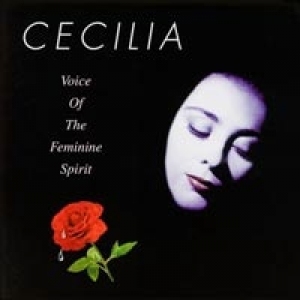 |
"Amazing Grace” with Humpback Whale Songs CD by Cecilia This is a spectacular rendition of the song Amazing Grace interspersed with actual whale song recordings. The Amazing Grace song (track 6 on the CD) is played at sunset every evening on my humpback whale swim trips with the North Atlantic Humpbacks in their winter home in Silver Bank, off the Dominican Republic. After each miraculous day in the water swimming with the whales, we play this song on the outside deck of our dive boat at sunset, holding hands and sending prayers and love to the whales. |
|
The song is our thank you to them—for gracing us with their physical presence, for their trust, and for the greatness of their love. The combined vibrations of this song—an alchemy of Cecilia's angelic voice, the wisdom in the whales' voices and the powerful energy of the original words—make it one of the most touching, inspirational pieces of music ever created. Our evening tradition of playing it is one of the most remembered highlights of these trips for many. This music takes you to the center of your soul, where all is well, where we are all aligned to God/Source. May it take you there with great love. Note: Cecilia has another CD actually titled Amazing Grace. However, the rendition of "Amazing Grace" on that album is not at all the same one as on this Voice of the Feminine Spirit CD. This one includes much more whale song and, I think, a much higher vibration of whale energy. |
|
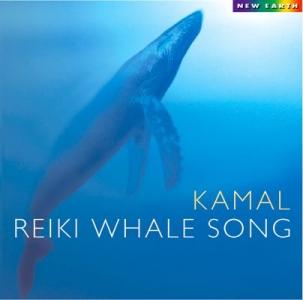 |
Reiki Whale Song by Kamal When you want music to help you come back to your center, or just to kick back and relax, bring the whales with you! After swimming with humpbacks, composer Kamal writes of being mesmerized, rejuvenated and elated while hearing their songs. The memory of that inspired this music. Actual songs of humpbacks, recorded by Roger Payne, are incorporated into soft, soothing, calming music suitable for healing sessions, private meditation, or for quiet background music while reading, relaxing or working. A must have CD for people who love both whales and soft meditation music. Enjoy! |
| From the Producer: Healing songs from the gentle giants of the deep echo throughout this unique collaboration of whale and man. Kamal blends authentic recordings of humpback whales with flute and soft synthesizer to create an atmosphere supportive of the healing energies of Reiki. Sacred Swims & Communication with Humpback Whales  |
|
Who Are Humpback Whales?
The sheer magnificence of these great whales, the unique and breathtaking beauty of these gentle giants, helps us define the wonder and glory of all life.
And their gentle acceptance of small creatures like ourselves teaches us that power need not be aggressive.
~ Lloyd Bridges, Whales and Dolphins of Hawaii video
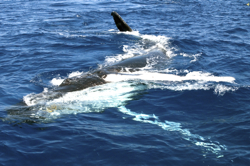
Humpback whales are magnificent beings. They are enchantingly beautiful and graceful, they sing, they are huge yet amazingly gentle and charming. You can easily become captivated by seeing their sleek black bodies glide through the water with the graceful movement of their long, white pectoral fins which appear as a lovely aquamarine blue when close to the surface. Their pectoral fins are the longest of any whales, making them look almost like angels as they move. You may gasp involuntarily when you see their huge flukes lift out of the water majestically, allowing you to see their beautiful, unique markings. You may scream or shout for joy when you watch them powerfully raise their full bodies out of the water to breach. Tears may come to your eyes when you hear their haunting songs, or watch their grace of movement, a grace surpassing that of any human ballerina. And your heart may swell when you feel their trust in coming so close to humans, a human—the same species who killed almost every member of theirs.
Facts about humpback whales:
Humpback whales are marine mammals of the order cetacea. They are different from their marine mammal cousins of the pinniped order in that as cetaceans they must live entirely in the water. Pinnipeds such as harbor seals and sea lions live in the water but also regularly haul out on rocks and land for long periods. Cetaceans cannot do this. As a mammal they must come to the surface to breath air, but they must remain in the sea. Humpbacks also belong to the suborder Mysticeti, meaning that instead of having teeth they have baleen. Other baleen whales are gray, blue, fin, right and minke whales. Odontocetes, or toothed whales, include killer, sperm, pilot whales and dolphins. The species name for humpback is Megaptera novaeangliae, meaning "Big Winged New Englander." Big winged for their long pectoral fins, and New Englander because the first recorded sighting of a humpback was from the shores of New England. The common name, humpback, is derived from the "hump" of the dorsal fin on it's back, and the hump that is created when they arch their backs to dive.
Status and Population:
Humpback whales are endangered. Between 1905 and 1965, whaling reduced their numbers from about 240,000 to a present estimate of 30,000 - 40,000. There are approximately 10,600 North Atlantic Humpbacks, the whales we see in Silver Bank in the Caribbean.
Distribution & Migration:
Humpbacks are found in all the world's oceans. Most of them follow a regular migration route, summering in cooler waters for feeding, and wintering in tropical waters for mating and calving. It is believed that approximately 3,000 to 5,000 humpbacks travel through Silver Bank each winter.
Physical Characteristics:

Illustration copyright Teresa Wagner
|
Length: Adult males 40-48 feet, adult females 45-50 feet. At birth: 12-15 feet. Weight: Adults 40-50 tons (about one ton per foot). At birth: 1 ton (2,000 pounds) |
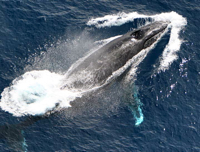
|
|
Dorsal Fin: This is the fin on the whale's back that we often see when they glide or float near the surface of the water. It is situated about 2/3 of the way from the mouth toward the back of the body. The shape of each humpback's dorsal fin is unique and helps with identification of individual whales. |

Photo from purchased photo CD,
Turks Caicos Aggressor II 2007 |
|
Pectoral Fins (Flippers): The longest of any whale, about 1/4 to 1/3 the length of its body. On North Atlantic Humpbacks, the color is usually white, with some black markings. On Pacific Humpbacks, the color is often all black or mostly black. |

Photo from purchased photo CD, Wind Dancer 2008
|
Fluke (Tail): About 15 feet wide and is serrated and pointed at the tips.
Fluke Markings:
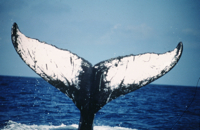
copyright Kaz Zirkle
When a humpback dives deeply (called "sounding"), it usually lifts its fluke upward, exposing black and white markings on the underside, as on the photo above. These markings are unique to each whale. Considered the "fingerprints" of humpbacks, the markings make visual identification of individuals fairly easy. "The discovery of this interesting fact changed the course of cetacean research forever, and the new form of research known as "photo-identification," in which individuals are identified, catalogued, and monitored, has led to valuable information about such things as humpback whale population sizes, migration, sexual maturity, and behavior patterns." (American Cetacean Society Fact Sheet)
Head, Mouth and Throat:
The top of the humpback's head as well as the lower jaw have a number of round, bump like knobs called tubercles, each of which has a stiff hair. At close range, these knobs make their heads look very cucumber-like. It is believed that the hairs may provide a sense of touch, but the purpose is not known for sure.
From the tip of the mouth to the navel, they have about 20-35 ventral grooves, allowing their bodies to expand tremendously while feeding. This makes their entire lower jaw area look so blown up it appears pelican-like.
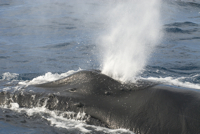
Inside their mouths, humpbacks have baleen plates, not teeth. Baleen is composed of keratin (what human fingernails are made of), and is situated in the whale's mouth in plates, hanging from each side of the upper jaw. Plates can be up to 30 inches long, black in color, and fringed on the ends. Each humpback has about 270-400 of these fringed overlapping plates. When they feed, they take in large amounts of water along with their small prey (thanks to those expanding throat grooves), pushing the water out with but their tongue but keeping the food trapped in the mouth (thanks to the fringed baleen).
Feeding:
Humpback whales feed on krill, tiny shrimp-like crustaceans, and small fish such as sand lance (in Stellwagon Bank in the Gulf of Maine) and herring (in Alaska). Each whale eats up to 1 and 1/2 tons of food a day. Humpback calves drink about 120 gallons of milk from their mothers each day.
Breathing:
Humpbacks use their blowholes for breathing, not their mouths. Like all baleen whales, humpbacks have two blowholes, while toothed whales have one. When a whale exhales, a mist called a blow or a spout rises above the surface about 20 feet. A whale will usually blow several times before diving. Seeing these beautiful spouts is what allows us to locate the whales' position from quite a distance. Up close one can hear the peaceful "whoosh" sound of the whale breathing. But even from far way, even from land, a whale spout is an awesome sight.
Mating and Breeding:
 Photo purchased from Wind Dancer photo CD 2008
Photo purchased from Wind Dancer photo CD 2008Mating, giving birth and nursing occurs only in the warm, tropical waters, such as the Caribbean or Hawaii, in winter months every year. They reach sexual maturity and begin to mate at about 6-8 years of age or when males reach the length of 36 feet and females reach about 40 feet. Females typically bear a calf every 2-3 years with a gestation period of 12 months. Calves nurse on mother's rich milk of about 40% - 60% fat content. Calves are weaned to solid food at about one year old.
to hear messages from the whales
More information on the natural history of humpbacks
Watch DVDs with breathtaking footage of whales underwater and above water.
See our Photo Gallery on Facebook to view many more images




